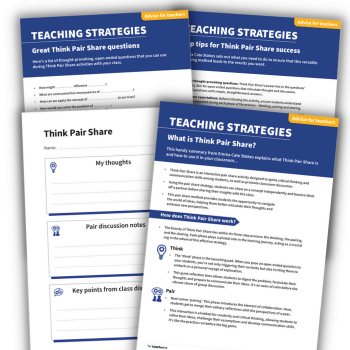Talk partners – the what, the why and the how

Learn the most effective way to use this classroom staple, including important dos and don’ts…

- by Jack Dabell

You’ve probably heard about talk partners and may well have used this teaching strategy already.
However, because it’s a classroom staple, you may not have thought any more deeply than, “This is a good thing to do, I’ll add it to the lesson plan.”
Let’s have a deeper look at talk partners as a teaching tool. What is it? Why should you use it? And most importantly, how should you use it?
What are talk partners?
Thankfully, “talk partners” is a fantastically self-explanatory term. It’s when children partner up (though it can be more than just two) and discuss a topic.
It’s sometimes called think pair share, because it’s often a three-stage process. First you pose a question or talking point. Secondly, children partner up and talk about it. Finally some students share what they were discussing with the whole class.
This is a very quick technique that you might do multiple times in one lesson. You may want to specify a time limit for the talking section – 30 seconds to a couple of minutes is typical.
Use this strategy during your teacher input part of the lesson, or try it at another point when you think it would be beneficial.
Why is it a good strategy?
The success of talk partners is that it gets children involved and engaged in their learning – something most of us would agree is important in helping children to progress.
One of the biggest benefits when it comes to talk partners is building children’s confidence. Pupils who are less confident to speak in class can discuss their ideas with a peer. This helps them to articulate their thinking.
Even if that child isn’t the one to share the pair’s idea with the class, they still get the benefit of being more involved in the discussion.
Another benefit is the increase in thinking time. You might fall into the trap of not giving enough time for this. Properly planning to use talk partners ensures more thinking time. This then lead to more articulate answers, which leads to better engagement for all.
“One of the biggest benefits when it comes to talk partners is building children’s confidence”
Another benefit of talk partners is the amazing opportunity it gives you and the other adults in the room to observe and listen to children doing something incredibly important: talking.
Challenges you may face
There are two main challenges that can arise with talk partners. First, the relationships between children. Partners can get stale, and some children don’t like talking to particular children.
One pupil might be too dominant in the pair which negates some of the positive effects for the other. You need to monitor your talk partners as they work together. Their conversations should be balanced and constructive. If they aren’t, change them.
Secondly, how you choose to use the strategy can hinder more than it helps. For instance, you might plan to use the strategy at the wrong time or let the talking go on too long. These were both problems I encountered when I first started using the approach in the classroom.
Remember, talk partners are there to help children get involved. This means you may need to adapt the strategy for children who use non-verbal communication and/or children with additional support needs. You need to ensure that all children in your class benefit from some part of the process every time.
How to use talk partners
It’s very important to introduce talk partners correctly. Because it’s a common teaching technique, you might have a false sense that it’s already an embedded practice.
However, even if your class used talk partners with their previous teachers, you need to introduce and model how it works in your classroom.
The first time you want children to use talk partners, choose one of your more confident pupils and model it with them. Ask another child (or your TA) to pose a question to you. Then model a short discussion with your volunteer.
Focus on being clear, sticking to the point and listening to the other person – all the things you want the class to be doing.
Talk partner dos and don’ts
Do:
- Listen to the other person
- Make sure both people get a chance to say something
- Be respectful of other people’s ideas
Don’t:
- Look bored when the other person speaks
- Talk about something completely unrelated
- Let your partner do all the work
Choosing talk partners
Who goes with who is arguably the most important thing when it comes to using the talk partners strategy. There’s many different ways you can pair the children in your class – you know them best.
In my experience, and the experience of others, randomly generating talk partners and changing them often is a good strategy. (Although you may want to randomly generate these pairs after school so you can make small changes if necessary without prying eyes…)
In my classroom we changed talk partners every week. I recommend not keeping the same partners for more than two weeks.
Planning for talk partners
Once partners are picked, it’s time to plan. Planning when to use talk partners is more important than you realise. The best time to have children talk to their partners is after you pose an open-ended question. This is to incite more conversation and different interpretations.
Be clear with the children that there is no right or wrong answer. This helps to alleviate anxiety and promote discussion. When I started I found it helpful to include the times and questions in my lesson plan, but after a while it should become more instinctive.
“Planning when to use talk partners is more important than you realise”
When planning your lesson, decide which key questions you’re going to ask and when these will be followed up by talk partners. In my experience, three times in a lesson is about right.
As for how long each instance takes, you want to keep the balance between maintaining the pace of your lesson but giving enough time for it to be valuable to the children. Try one minute for discussion and then two minutes to share with the class. Another tip is to put a timer on your board.
Sharing with the class
Children sharing their ideas with the class is just as important as talking about them with their partner. There’s a few different ways you can do this:
- Select a few pairs to share their ideas with the whole class
- Randomly select pairs to share with the rest of their table (you can join a different table each time)
- Ask children to write their key points on a mini whiteboard and hold it up
However you do it, praise children who share. Fostering a healthy outlook on sharing ideas, and being respectful of others’ ideas, will do wonders for your classroom ethos.
Examples of praise
Speaking of praise, make sure it’s constructive and meaningful during every step (“well done” and “good listening” are neither).
Try: “Artem, I saw you were really listening to Anna while she was talking because you were looking at her and asking questions. Great work.”
Or: “Matias I love how confidently you just spoke in front of the class. You and your partner worked hard in organising those thoughts.”
Talk partners can be one of the easiest and most useful tools you have as a teacher. Plan when to use them. Use open-ended questions. Change your talk partners often. Involve yourself in the discussions and praise, praise, praise.
Jack Dabell is education advisor at Tapestry, the online learning journal, and a former primary school teacher. He also writes for the Foundation Stage Forum.











